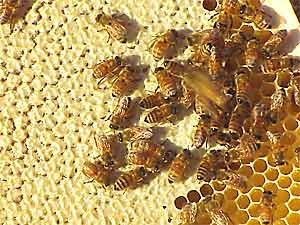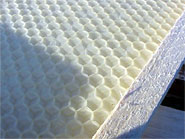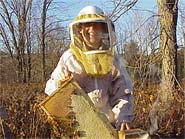
Assuming you have an interest in plants and nature -- and an absence of bee phobia -- you may have already considered adding hives for honeybees to your garden. But the prospect can be a little daunting.
If you've never considered the possibility of raising bees, think of all the garden crops that rely upon pollination. Even accounting for native bee pollinators, honeybees still do most of the pollinating of fruits and vegetables in your garden. If you've ever suffered poor fruit sets of apples, cherries, cucumbers, melons, or strawberries, the reason might be too few honeybees. And then, of course, the honey you will harvest is your reward for keeping your garden pollinated and your bees healthy.
Small-scale beekeeping is very doable. But before you plunge too deep, a few preliminaries need to be covered. If you're in an urban or suburban environment, check with your neighbors to see if they have bee sting allergies. Some people have severe, even deadly, reactions to bee stings.
The other necessity is more bureaucratic: registration and fees. Some states and municipalities have them, and some don't. Where fees exist, they are nominal. For details, contact your state apiarist through your nearest agricultural extension office.
By far the most efficient way to deal with local rules -- not to mention the nuances of beekeeping -- is by connecting with other, more experienced beekeepers. Virtually every state has a local association whose members enjoy sharing information. The best place to find them is at the Web site maintained by A.I. Root Co., publishers of Bee Culture Magazine: www.beeculture.com/.
The next consideration is finding an appropriate site for the hives. Look for a sunny, east-facing location so the bees will receive early light and warmth to stimulate foraging. Avoid low spots that might flood, as well as high, exposed, or windy locations. Avoid collisions with people and animals by placing the beehive away from walkways. A good place is near shrubbery or a fence where the foraging bees have to fly up first before flying through your yard. Another good site is a flat roof with some shade.
 Inside a Beehive
Inside a Beehive
The most basic hive consists of eight parts or layers. I'll review them from the bottom up. A hive stand keeps the hive off the ground; a bottom board provides a floor for the hive; an entrance reducer excludes mice in winter; a brood chamber (also called deep super or brood nest) holds the comb frames where the queen lives and lays eggs; a queen excluder prevents the queen from moving up into smaller boxes and laying eggs there; a super (or honey super) iswhere worker bees store surplus honey; and at the top there is an inner cover and an outer cover.
Inside the brood nest and each super box are 9 or 10 frames for comb-containing foundation, thin sheets of beeswax or plastic that are imprinted with a honeycomb pattern. Foundation helps the bees draw out straight combs within the wooden frames and allows you, the beekeeper, to remove the frames for inspection and to extract the honey from the combs without damaging them. Altogether, the hive and contents cost about $100.
Depending on your locality and flowering season, most beekeepers expand hive capacity by doubling both the brood nest and supers. Additional supers may be needed for honey storage.
 Tools You Need
Tools You Need
Most beekeepers have complete protective gear, which includes a veil to protect the head and face, white coveralls to protect clothes, and gloves and boots to provide some sting protection. A smoker is essential to calm bees while you work around them, and you'll also need a hive tool -- essentially a pry bar -- to separate boxes that bees glue together. The cost of this gear amounts to about $140.
Basic Bee Care
Care boils down to providing your bees with food, water, and sufficient hive space. Bees' food, which they collect from flowers, is pollen for protein and nectar for carbohydrates. The bees convert the nectar to honey within the hive. If you live where some flowers are always blooming, you simply make sure the bees are located near enough to find them. If you live where no flowers are in bloom for periods of time, you'll have to supply supplementary food -- pollen patties and sugar syrup -- for your bees. If you overwinter your hive, don't harvest all the honey from the hive. Again, check with local beekeepers to determine how much honey must be left for the bees to survive on for the winter.
Water is another matter. Bees need it every day. If you can't place the hive near a natural source, you'll have to provide water, ideally from a slowly dripping faucet or a dish with a piece of screen on the water so the bees can land. You don't want your bees crowding around a neighbor's swimming pool or garden sprinkler looking to quench their thirst.
When bees outgrow their hive space, they tend to swarm. Swarming is colony reproduction. The queen and half of the bees fly off to begin a new hive, and the remaining bees raise a new queen and continue reproducing. Beekeepers can prevent their colonies from swarming -- and avoid losing honey production -- by providing ample hive space. Add new brood boxes when the first box is full of bees; add additional honey supers to encourage the bees to expand their hive and store lots of honey.
Bee Problems
Honeybees suffer from two parasitic mites that were inadvertently introduced to this country in the 1980s from Asia, and from occasional diseases infectious only to honeybees. Because of the mites, many bee colonies that normally lived in trees and abandoned structures have been lost, so virtually the only honeybees existing are those owned by beekeepers. The mites don't affect other bee pollinators, such as bumblebees and leaf-cutting bees. All bee pollinator populations are low because of habitat destruction, pesticide use, and their own sets of parasites and diseases. You can see why beekeeping is very important for pollination, particularly in locations where there are no other beekeepers.
To obtain up-to-date information on how to control mites and diseases, check with the state apiarist, university extension personnel, or a local beekeeping association. Make sure the treatments you use are registered as safe, and follow label directions exactly.
Within the research community, there is a great effort to breed bees with natural defenses or resistance to mites and diseases. For example, bees that display "hygienic" behavior readily remove diseased and parasitized brood (immature bees) from the hive, which prevents the spread of infection through the colony. However, to date no bees within the United States are 100 percent resistant. At some point, the bees will require treatments, so keep current on which are the safest and most effective.
Beekeeping is at once both simple and complex. Use catalogs and information sources, and check with local experts. But most of all, get started. That's the best way to learn.
Marla Spivak, an entomologist at the University of Minnesota, specializes in apiculture.